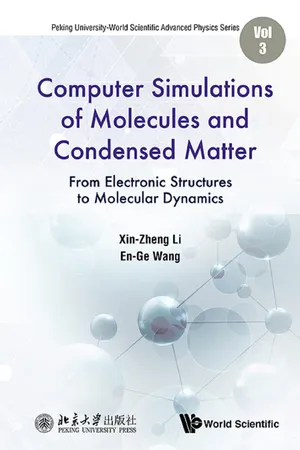
Computer Simulations of Molecules and Condensed Matter
From Electronic Structures to Molecular Dynamics
- 280 pages
- English
- ePUB (mobile friendly)
- Available on iOS & Android
Computer Simulations of Molecules and Condensed Matter
From Electronic Structures to Molecular Dynamics
About This Book
-->
This book provides a relatively complete introduction to the methods used in computational condensed matter. A wide range of electronic structure theories are introduced, including traditional quantum chemistry methods, density functional theory, many-body perturbation theory, and more. Molecular dynamics simulations are also discussed, with extensions to enhanced sampling and free-energy calculation techniques including umbrella sampling, meta-dynamics, integrated tempering sampling, etc. As a further extension beyond the standard Born-Oppenheimer molecular dynamics, some simulation techniques for the description of quantum nuclear effects are also covered, based on Feynman's path-integral representation of quantum mechanics. The book aims to help beginning graduate students to set up a framework of the concepts they should know before tackling the physical/chemical problems they will face in their research.
--> Contents:
- Introduction to Computer Simulations of Molecules and Condensed Matter
- Quantum Chemistry Methods and Density-Functional Theory
- Pseudopotentials, Full Potential, and Basis Sets
- Many-Body Green's Function Theory and the GW Approximation
- Molecular Dynamics
- Extension of Molecular Dynamics, Enhanced Sampling and the Free-Energy Calculations
- Quantum Nuclear Effects
- Appendices:
- Useful Mathematical Relations
- Expansion of a Non-Local Function
- The Brillouin-Zone Integration
- The Frequency Integration
- References
- Acknowledgements
-->
--> Readership: Researchers in computational condensed matter physics. -->
Keywords:Electronic Structures;First-Principle;Molecular Dynamics;Path-IntegralReview: Key Features:
- Elaboration on a framework of concepts based on the authors' research experiences
- Illustrations of methods ranging from electronic structures to molecular dynamics
- Detailed explanation of the path-integral method
Frequently asked questions
Information
Table of contents
- Cover
- Halftitle
- Title
- Copyright
- Preface
- 1. Introduction to Computer Simulations of Molecules and Condensed Matter
- 2. Quantum Chemistry Methods and Density-Functional Theory
- 3. Pseudopotentials, Full Potential, and Basis Sets
- 4. Many-Body Green’s Function Theory and the GW Approximation
- 5. Molecular Dynamics
- 6. Extension of Molecular Dynamics, Enhanced Sampling and the Free-Energy Calculations
- 7. Quantum Nuclear Effects
- Appendix A: Useful Mathematical Relations
- Appendix B: Expansion of a Non-Local Function
- Appendix C: The Brillouin-Zone Integration
- Appendix D: The Frequency Integration
- References
- Acknowledgements
- Index